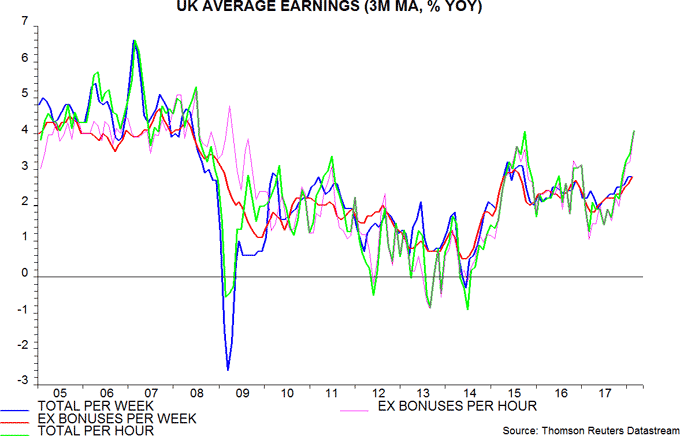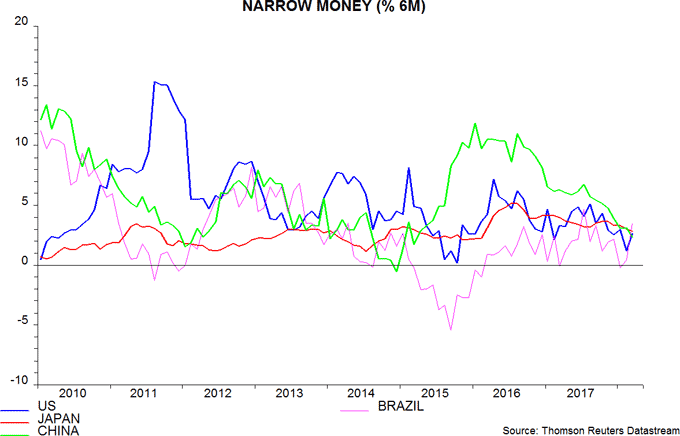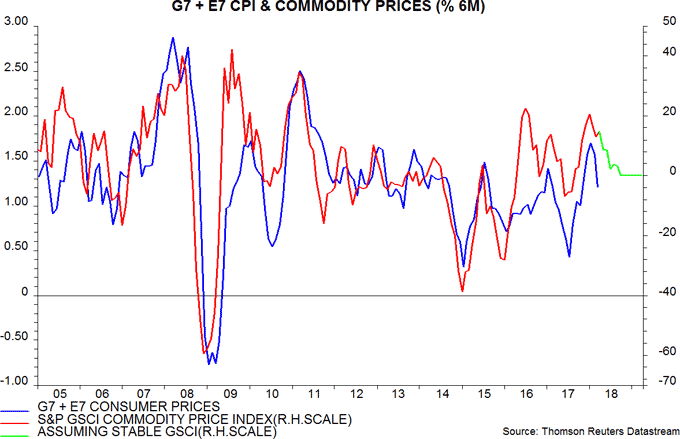Entries from April 15, 2018 - April 21, 2018
Will Chinese policy easing work?
Satisfactory Chinese activity numbers for the first quarter / March are consistent with monetary trends in mid-2017. Subsequent monetary weakness, which continued in March, suggests a significant slowdown over the remainder of 2018. The authorities appear to be shifting tack to head off economic weakness. Late cycle policy easing can prove counter-productive by boosting prices, thereby exerting additional downward pressure on real money trends.
This week’s activity numbers were mostly solid, although annual industrial output growth fell to a seven-month low in March as an upward distortion from the late timing of the Chinese New Year unwound (discussed in a previous post).
Two-quarter growth of nominal GDP, seasonally adjusted, rose slightly further last quarter, consistent with a stabilisation / small recovery in six-month narrow money expansion in mid-2017 – see first chart.
Narrow money trends, however, weakened sharply after September, with six-month growth falling further in March to its lowest since January 2015, suggesting a significant loss of economic momentum alongside weaker inflationary pressures through late 2018.
Credit trends are also concerning: the percentage increase in the stock of “total social financing” in the first quarter, of 3.2%, was the lowest on record in data extending back to 2004.
The authorities, therefore, appear to be moving to ease policy. A fall in term interbank rates in early April suggested that a shift was under way and this week’s reduction in the reserve requirement ratio for a range of banks, involving a net increase in liquidity supply, offers confirmation.
Market perceptions of a Chinese policy turnaround may have driven this month’s recovery in risk assets and contributed to renewed strength in commodity prices.
As previously discussed, Chinese loosening, together with a recovery in US narrow money growth in lagged response to tax cuts, could result in a revival in the global real money growth measure tracked here. Late cycle policy easing, however, can be ineffective or even counter-productive, feeding directly into higher prices without boosting nominal money trends.
The US FOMC was not, as is sometimes claimed, asleep at the wheel in the run-up to the 2008-09 recession – it cut the fed funds target rate by 100 basis points between August and December 2007, with the US recession beginning in January 2008, according to the NBER. Policy easing, however, contributed to a surge in commodity prices that continued into mid-2008. This surge fed through into global consumer prices and, with nominal money trends remaining weak, was an important reason for the six-month change in real narrow money turning negative – second chart.
UK MPC on course for risky rate hike
UK labour market statistics confirm stronger wage cost pressures and suggest that the MPC will press ahead with another interest rate increase next month. The view here remains that the Committee should hold fire because of worryingly weak monetary trends.
Annual growth of average weekly earnings, smoothed over three months, was unchanged at 2.8% in February and below a consensus forecast of 3.0%. The undershoot, however, reflected lower growth of bonus payments – the ex. bonuses measure moved up to 2.8%, the highest since 2015.
Hourly pay, moreover, is rising considerably faster because of a fall in average weekly hours worked over the last year. Hourly earnings growth, including or excluding bonuses, is estimated to have increased further to 4.0% in February, with the ex. bonuses measure the highest since 2009 – see first chart.

The recent acceleration of hourly earnings has outpaced a modest improvement in growth of productivity (i.e. output per hour), implying stronger unit wage cost expansion – second chart. Annual productivity growth rose to 1.0% in the fourth quarter of 2017 and may have increased slightly further in the first quarter, reflecting the dropping-out of a quarterly decline a year earlier. With hourly earnings growth at 4.0%, however, annual unit wage cost expansion may have moved up towards 3% last quarter, after 2.4% in the fourth quarter.

MPC concern about labour market overheating will be heightened by a further fall in the unemployment rate to 4.2% in the three months to February and 4.0% in February alone – below a forecast of 4.3% for the first quarter in the February Inflation Report.
Increased labour cost pressures support the view here that consumer price inflation will be slower to return to the 2% target than the MPC projected. As previously discussed, however, these pressures reflect past monetary and economic strength – current weak monetary trends suggest diminishing medium-term inflation risks, with narrow and broad money growing at annualised rates of only 1.6% and 1.1% respectively in the three months to February. A May rate hike would risk exacerbating this weakness.
Are global money trends stabilising?
A further fall in global real narrow money expansion in early 2018 suggests that a recent slowdown in economic activity will be sustained until late in the year, allowing for the typical nine-month lead. Previous posts (e.g. here) discussed reasons for thinking that real narrow money trends would stabilise or recover from the first quarter, a development that would provide some reassurance about economic prospects for end-2018 / early 2019. Partial monetary data for March are consistent with this scenario.
March monetary figures are available for the US, China, Japan and Brazil, together accounting for 60% of the G7 plus E7 aggregate tracked here. Assuming unchanged nominal money growth in the other economies, and taking into account March inflation data / forecasts, G7 plus E7 six-month real narrow money expansion is estimated to have returned to its December level, following February’s nine-year low. This would, however, still leave it below its range between September 2008 and November 2017 – see first chart.

The estimated March recovery reflects two factors: a rebound in US six-month nominal narrow money growth and a fall in the six-month rate of change of global consumer prices (seasonally adjusted).
As previously discussed, a rise in US narrow money growth into the third quarter of 2018 would fit the pattern after three previous large tax cuts. The Fed, as now, was raising interest rates as these tax cuts were enacted; the additional tightening implied by current and planned balance sheet contraction, however, could undermine the comparison. The weekly narrow money data fell back during March and will need to rebound in April to maintain alignment with the historical pattern.
Brazilian six-month narrow money growth also strengthened in March but Chinese and Japanese data were weak – second chart.

A fall in six-month global consumer price inflation had been suggested by recent commodity price trends – third chart. The March decline, however, was larger than expected – a further fall seems unlikely and a rebound is possible, unless commodity prices weaken significantly from current levels.

The estimated March recovery in global real narrow money expansion, therefore, is tentative and requires confirmation from April / May readings before concluding that nine-month-ahead economic prospects are improving. Such confirmation, of course, would not alter the forecast of a further economic slowdown through late 2018.
A firm March reading will be available in early May and will depend importantly on Euroland monetary data to be released on 30 April.



